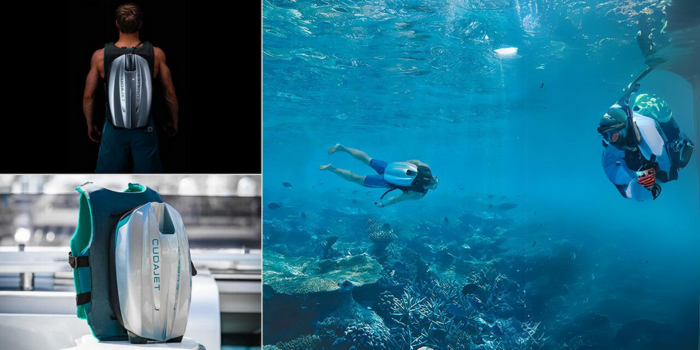
Underwater Jetpacks: Specs, Benefits, and Future Trends
What is an Underwater Jetpack?
An underwater jetpack is equipment that can allow the operator to control underwater just like a jetpack for control in the air. It enables the user to navigate fast and with ease through water providing the feel and experience the user would want. These actual jetpacks work with the help of motors and propellers to provide thrust and allow the user to swim, hover and even do flips.
The Evolution of Underwater Jetpacks
The use of Water jetpacks can be dated several decades back though; the present-day underwater jetpacks are completely different. The initial inventions were crude structures, and sometimes complex, but evolution in this aspect has seen machines designed with proper features with better functioning. Lithium-ion batteries, fiberglass body and construction, and other new age breakthroughs make underwater jetpacks to be more efficient for sports use as well as professional use.
Importance of Underwater Jetpacks in Modern Exploration
Underwater jetpacks are outstanding since they have brought change into the underwater world by allowing the user to be more capable. They are applied in sport diving, scientific research, lifesaving and other operations. This is because the mode of living acquired by the transformed animals lets them go from one place to the other in water hence exploring and doing other tasks more efficiently.
Technical Specifications
Core Components and Design
Underwater jetpacks typically consist of several core components:
- Motors and Propellers: The primary means of propulsion that is used for the generating of the necessary thrust and control of the aircraft’s motion.
- Frame and Housing: Constructed from immensely strong materials such as aluminum or other provided composite materials meant to survive underwater pressure.
- Control Mechanisms: Self-propelling or separable wheels that enable the users to control their directional and or speed.
- Buoyancy and Stabilization: Admirable attributes to help support and float while in the water.
Performance Metrics
Performance metrics for underwater jetpacks include:
- Speed: Average speed varies within the band of 2 kn-6 kn.
- Battery Life: improper on average between 30 minutes to 2 hours depending on how frequently one uses it or the model of the particular ironing board.
- Depth Rating: Specially designed to work in a water depth of between 30 – 100 meters.
Power Sources and Fuel Types
Underwater jetpacks are powered by various sources, including:
- Electric Batteries: That is why they are rechargeable and safe for the environment and intended for recreational purposes.
- Hydraulic Systems: Recommended in the professional model with the higher force of thrust.
- Hybrid Systems: The following possibilities: batteries and fuel to get a longer cycle time.
Safety Features and Considerations
Safety features include:
- Emergency Shutoff: If there are some problems with the workings of the jetpack.
- Pressure Relief Valves: For protection against water pressure in deep water.
- Buoyancy Aids: Thus for one to easily surface in the event of an emergency, the follow button was added as a feature to the application.
Applications
Recreational Use
For people diving for fun or adrenalin purposes, underwater jetpacks provide them with the best way to navigate underwater. They give a kind of flexibility that will enable the users to swim the reefs, wrecks and open water. Several firms provide such gear for hire since some people would wish to experience underwater jetpacking when on a vacation or on a certain occasion.
Professional Diving and Underwater Work
Underwater jetpacks in professional use are widely adopted in underwater inspection, repairs, and construction jobs. They enable divers to move from one area to another faster and to execute maneuvers with a lot of elegance, thus they are useful in fields such as marine engineering and underwater archeology.
Military and Rescue Operations
Underwater jetpacks are useful in military operations, especially in situations where the military personnel needs to be deployed underwater quickly. They are also used for rescue operations to save the trapped divers or for operations of searching and rescuing efficiently.
Scientific Research and Exploration

People who work underwater to study sea life and other oceanic-related activities utilize underwater jetpacks. The freedom of motion as well as accessing areas that would otherwise be hard to reach helps in the study of marine life and the ocean Abyss.
Benefits
Enhanced Mobility and Freedom Underwater
Another advantage of acquiring underwater jetpacks is that the movements are more flexible. It can move forward, backward, and sideways and can turn around with unparalleled ease; this makes exploring fun.
Improved Efficiency for Professional Tasks
In the aspect of performance and productivity for professional divers and those working underwater, the use of jetpacks increases productivity through the time and energy that is needed to execute tasks. They facilitate fast navigation and fast movement to and from various working areas.
Fun and Adventure for Recreational Users
As a form of entertainment, underwater jetpacks are fun, being a mechanism that makes use of jet propulsion and at the same time allowing the user to enjoy underwater travel. If you are a sucker for a good adventure, then you will love them.
Challenges and Limitations
Technical and Mechanical Issues
However, underwater jetpacks are not devoid of common technical problems like motor failure or battery issues and mechanical faults of a jetpack. Proper usage and proper care for proper functioning are required from time to time and proper handling of the machine.
Safety and Risk Management
There are challenges though and using an underwater jetpack, one is likely to meet an accident. One has to choose the right training program, and strictly follow all the necessary safety procedures to avoid such risks.
Environmental Impact
Possible negatives associated with their use are the influence on sea life and the environment by underwater jetpacks. To this effect, measures are being undertaken to ensure that more environmentally friendly models are designed and implemented reducing the rates at which the environment is exploited.
Cost Considerations
As for the drawbacks of underwater jetpacks, they can be very costly, with the price range starting from a few thousand dollars and going up to thousands of tens of thousands of dollars. The cost acts as a limiting factor for the daily users or the more common users who use it for leisure.
Latest Innovations
Recent Technological Advancements
The new advancements in underwater jetpacks have been seen in improved battery, power, and control of the jetpack. It also amounts to more working hours, efficiency, and comfort for the users or clients using the machines.
New Features and Enhancements
The advancements in underwater jetpacks include having cameras that are attached to the jetpacks to capture underwater scenes, enhanced navigation systems as well as touch panel options for different users and uses.
Innovations in Design and Functionality
The concept advancements in the car deal with body shapes, materials, and accessibility. Examples of functional improvements can be mentions of improved and even more maneuverable rafts, and their enhanced durability for severe underwater use.
Future Prospects
Predictions for Future Developments
As for the further development of underwater jetpacks, future options and outlooks would embrace the use of AI for controlling the device and power supply improvements. It has been projected that these developments are bound to increase performance and add to the number of applications.
Potential New Applications
Underwater jetpacks could be used in new recreational areas such as underwater parks that offer an opportunity to take a flight with the jetpack, underwater explorations, and research in deeper oceans and with new uses in the construction and repair of underwater structures.
Upcoming Trends in Underwater Jetpack Technology
Some further trends are expected to be incorporated into other technologies like augmented reality for direction and advanced materials for added features and security.
Comparative Analysis
Comparison with Traditional Diving Equipment
It is reported that underwater jetpacks provide more flexibility and faster compared to conventional free diving equipment. Nevertheless, they demand diverse protection measures as well as various operations in terms of their upkeep.
How Underwater Jetpacks Stack Up Against Other Personal Watercraft
Over the underwater scooters and submersibles, underwater jetpacks show better opportunities in terms of flexibility and the sense of underwater excitement.
User Guides and Tutorials
How to Operate an Underwater Jetpack
To fly an underwater jetpack one has to learn how to control it, know the principles of the power plant, and perform some basic exercises. Precautions include training and practice to avoid the misuse of these products.
Maintenance and Care Tips
The main areas are the motor, battery, and structure; they have to be checked often for any signs of wear and tear. To enhance the overall life expectancy of the jetpack, it should be clean always and be stored in a dry area.
Troubleshooting Common Issues
Among those are battery problems, motor failures, and control-related problems. The tip concerning checkups covers such areas as checkups of connections, charging of battery and checkup of assembly.
Conclusion
Summary of Key Points
The underwater jetpack is therefore one of the interesting and new technologies that people can use to travel underwater. They afford better accessibility, productivity, and thrill for leisure, business, and research purposes.
The Future of Underwater Jetpacks
Currently, it is possible to expect further development of underwater jetpacks and possibly other uses shortly. In the future, underwater jetpacks will likely not only be more affordable but also more handy than it is today.
Call to Action for Further Exploration and Learning
Those who have come across the underwater jetpacks will need to enroll for training or else can get a model that they can experiment with. Volunteer to remain updated on the existing trends as well as the new inventions to maximize the usage of this thrilling technology. Explore cutting-edge insights and trends in technology on our CGit blog.
FAQs
How deep can an underwater jetpack go?
Are underwater jetpacks safe for beginners?
What maintenance is required for an underwater jetpack?
Can underwater jetpacks be used in both saltwater and freshwater environments?
How do underwater jetpacks compare to underwater scooters?
You may also like

Freelancing SEO Services on Fiverr to Make Sites Visible

Get Hostinger Referral Discount – Exclusive Offer


